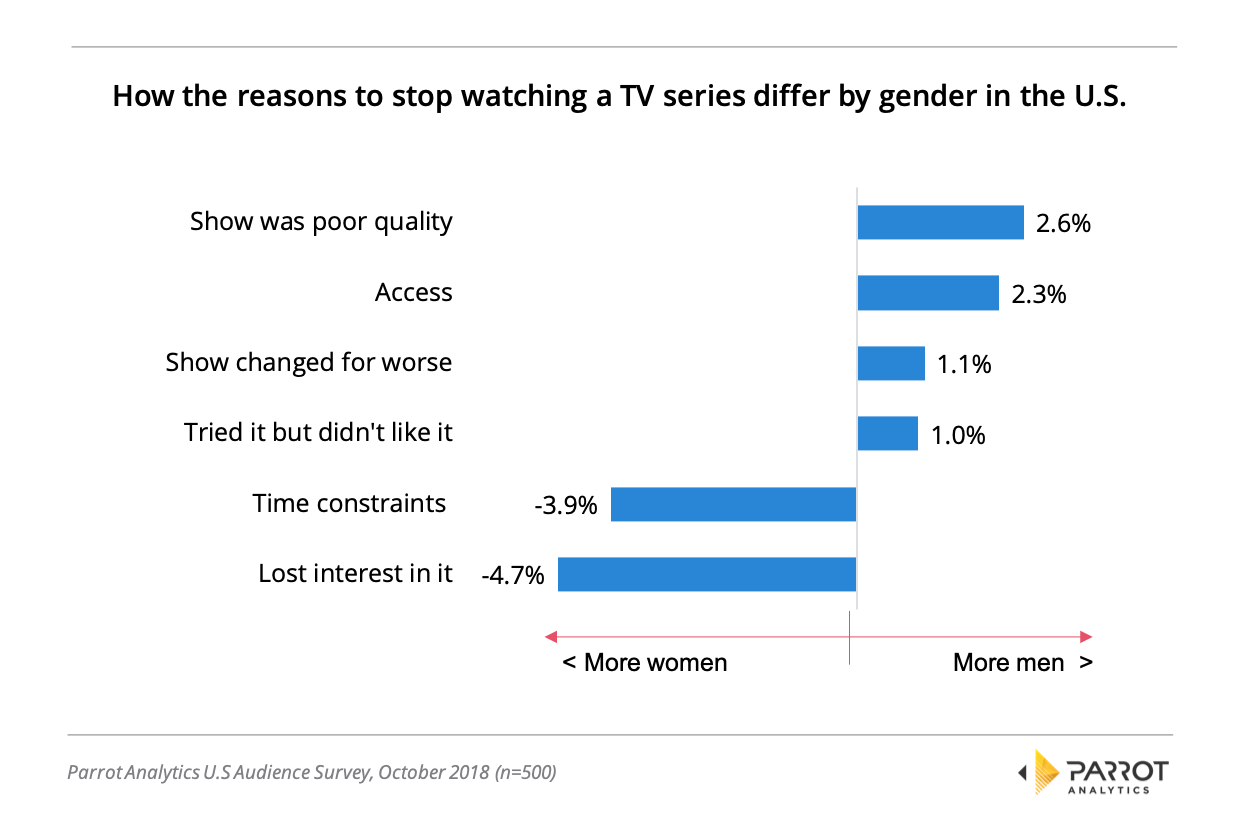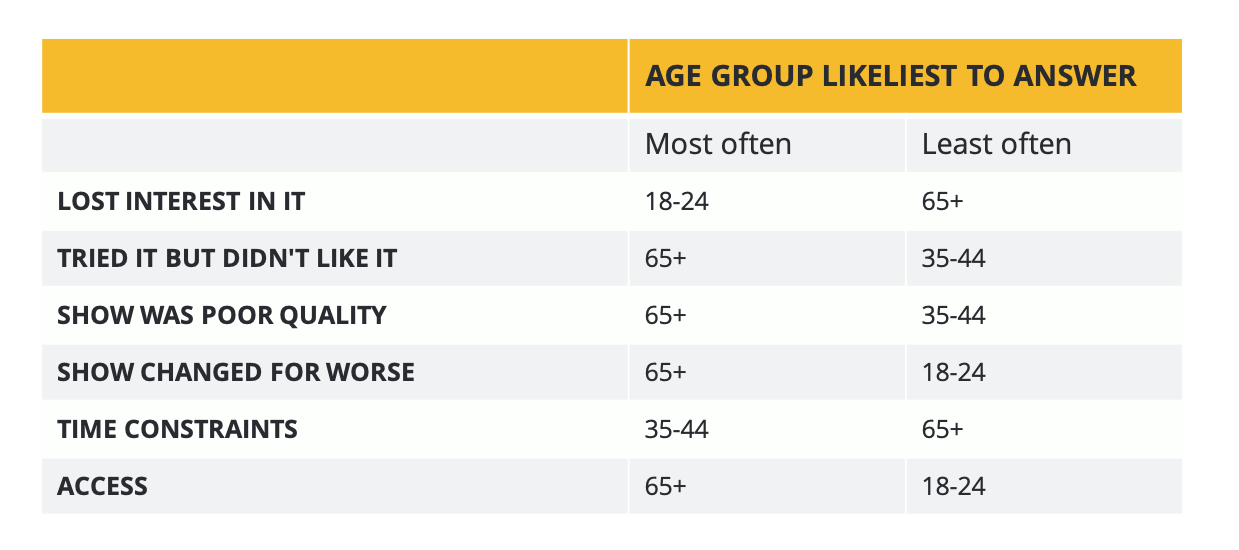With content budgets in the tens of billions of dollars continuing to rise there have never been more shows for viewers to choose from: In 2017 more new scripted series debuted in the US than in any previous year and 2018 is likely to break that record.
We have previously investigated the reasons that most often enticed American audiences to try a new show. However, getting a viewer to give a show a chance is only half the battle: Now that viewer must continue to watch the series. This is not an easy task: Many promising titles premiered strongly but could not retain audience interest to the end of their debut season (often the reason why a series is ultimately cancelled).
To discover the main reasons that cause American audiences to give up on a TV series, Parrot Analytics commissioned a survey asking the following question: “When you begin watching a TV show and you don’t finish the season – what is the reason you stopped watching it?”
The survey involved participation from 500 respondents in the USA with an open answer field: Participants could write down as many reasons as they desired.
Americans simply lose interest in a show most often
This chart shows how Americans answered this question, showing the most common reasons for American audiences giving up on a show. (Note: Participants could write answers that included multiple reasons and thus the percentages may not add up to 100%).
With 39.3% of answers, by far the most common reason Americans gave for giving up on a TV series is that they “Lost interest in it”, this being an answer that indicated that the respondent had a gradual fading of enthusiasm for the title over time until they stopped watching it. Typical responses included “grew tired of it” and “not interesting enough to keep watching”.
The second most common reason given was “time constraints”. Although it is easy to focus on the fact that TV shows compete with each other for audience attention, they are also competing with every other activity in modern life. 25.8% of the respondents in this survey gave the reason that something else took priority over the time they used to spend watching the show and they became too busy to finish it, with the most common specific causes mentioned being “sleep” and “children”.
We also discovered that 12.8% of respondents gave the reason that something about the show’s quality caused them to stop watching: Respondents in this category tended to decide a show was not for them very quickly due to a quality factor that was immediately obvious, such as bad acting, poorly-written dialogue or low production values.
Similarly, the next most common response was also a category where viewers tended to give up on a show quickly, the 10.6% who said they “tried it but didn’t like it”. This category includes answers where people discovered quickly that the show was not for them. The difference from the previous category is that there isn’t necessarily anything at fault with the show itself, it just isn’t to the taste of the viewer. Typical answers given for this category are “not what I expected” and “it was too intense”, with horror shows being the most frequently cited genre in this category.
4.9% of respondents said that they had stopped watching a TV series because the “show changed for the worse”, meaning there was a major change to the show that they disliked – enough to outright stop watching it. This is fairly similar to the “lost interest” category, with the difference between the two being that the “lost interest” answers were gradual and often could not identify any cause as being behind the loss of interest. In contrast, answers in the “changed for the worse” category point to a specific event that directly caused the viewer to stop watching the show – like a character death.
Perhaps surprisingly, 4.2% of the respondents stopped watching a show because they lost access to it, for example the respondent who answered that they “couldn’t finish watching it during the free trial”. As an increasing number of shows change services, for example, sci-fi hit The Expanse moving from Syfy to Amazon, this category is likely to grow. (We have previously covered American’s reluctance to pay for SVOD services).
On a lighter note, a single person in this category answered that they had stopped watching a show because it “conflicted with a show on another channel”, which is an answer that seems more at home in 1988 than 2018!
The final category of answers is the 2.4% who gave an answer that did not fit into any of the categories above. While the exact reasons given here naturally varied widely, the largest portion (around 35% of this group) were those who said they had stopped watching a show for political reasons, with an example answer being the respondent who stopped watching because they were “upset with constant pushing of political agenda in the show”. While a minor factor overall, this reflects how the increasing political polarization of the USA is affecting the entertainment choices of Americans.
Men are less tolerant of poor quality, while women are more likely to simply lose interest
Deeping the analysis, we next examined how the rate of responses given changed depending on the gender of the survey participants.
Here we saw that American women are more likely to answer that they lost interest in a title, 4.7% more women than men choosing this answer. Women were also 3.9% more likely than men to stop watching a show because of other commitments. Further to that, one of the most common specific time constraints named in this category overall was “children”; 100% of respondents who gave this reason were women.
American men are 2.6% more likely than women to stop watching a show because it was poor quality. They are also 2.3% more likely to lose access to a show they are watching, preventing them from continuing. Finally, US men are also slightly more likely than US women to answer that the show “changed for the worse”, and, they “tried but did not like the show”, at 1.1% and 1.0%, respectively.
Youth viewers gradually lose interest while older viewers are likely to bail fast
Finally, we investigated the differences in answer rates when the age of the survey participants was taken into account.
Every age group except those 65+ was most likely to give the lost interest reason most often, with those aged 18-24 having the highest incidence; 57% of respondents in this age group gave this reason. In contrast, the 65+ age group only gave this answer 35% of the time.
Because the 65+ age group answered least frequently on the most common overall answer, respondents in this group distributed more evenly across the categories than other age groups, making them the demographic that gave four answers most often of all demographics.
The only other demographic to most likely answer with a category is those aged 35-44, which is the demographic most likely to answer that they stopped watching a show because of time constraints; the 65+ age group was least likely to give this answer.
Finally, the 18-24 age group had the only category with an answer rate of 0%: No survey participants in this age group said they had stopped watching a show because of access issues.
For more information, reach out to Parrot Analytics for a live demonstration of our Demand Portal, or watch our latest product video.




